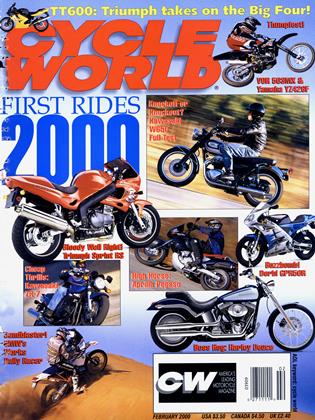FIRST RIDERS 2000
Aprilia Pegaso 650
Winged workhorse
ONCE IN A GREAT WHILE, A motorcycle comes along that threatens to turn your perceptions upside-down. Where previously you needed a garageful of bikes, each with a specific purpose, you suddenly realize that you just might be able to get by with one versatile, do-it-all machine. Call it a “multi-purpose” bike.
Aprilia calls it the Pegaso 650. You’re probably already familiar with the Pegaso (the name is Italian for Pegasus, the mythical winged horse). In 1993, when BMW was looking for a middleweight on which to hang its name (and in turn its reputation), the Pegaso got the nod. The resultant BMW F650 Funduro became an overnight sensation in Europe, and was duly imported into the U.S. beginning in 1997. Now that Aprilia is entering the U.S. market, the Pegaso is available stateside as well.
While the two bikes share the same basic platform, there are a few detail differences. Most significantly,
BMW’s engineers specified a fourvalve cylinder head for the Austrianbuilt, liquid-cooled, 652cc, dohc Rotax Single. The Aprilia has a five-valve head for the same reason a Cagiva Mito 125 has a seven-speed gearbox— it looks sensational emblazoned across the fairing. It certainly doesn’t boost performance: Our Pegaso made just 37.2 horsepower and 33.2 foot-pounds of torque at the rear wheel, compared to 41.6 bhp and 37.3 ft.-lbs. for the F650ST we last tested.
But if the Aprilia is lacking a bit in terms of power, it makes up for it in styling. (It is, after all, Italian.) For instance, where the BMW wears a nondescript fairing with a square headlight and individual round gauges, the Aprilia boasts such niceties as a colormatched seat and windscreen, sleek (and bright!) multifocal dual halogen headlamps and an aluminum dashboard with a slick integrated instrument panel. And where the BMW is saddled with an ungainly, catalyst-equipped muffler, the Aprilia sports sexy, squaresection dual mufflers that exit, Ducatistyle, under the seat.
But enough of this comparing apples and apples. How does this winged horse fare once it takes flight? Around town, the Pegaso impresses you with its light handling and rightnow throttle response that let you flow through traffic like water through a sieve. On the open road, you appreciate the roomy, upright seating position, the impossibly ample protection afforded by the tiny tinted windscreen and the supple suspension that soaks up bumps big and small.
What you won’t notice is vibration; the engine’s balance shaft, combined with spongy footpegs, heavy bar-end weights and a thickly padded saddle, makes for a smooth ride and fuzz-free mirrors at speeds up to 85 mph.
Point the Pegaso down a twisty backroad and you find that it works pretty well there, too. Not surprising, considering the stiff twin-spar aluminum frame, stout Marzocchi 40mm inverted fork and strong two-piston Brembo front brake are all sportbikespec. Only if you make a sudden, violent direction change does the chassis complain, bucking in protest as the long-travel suspension strokes up and down and the Pirelli MT80s’ tread blocks walk across the pavement.
Dare to venture off-road, though, and the Pegaso’s soft white underbelly is revealed. While extras such as handguards and a skidplate suggest the bike is rigged for dirt duty, standard-issue street stuff such as slipperywhen-wet rubber footpegs and flimsy foot controls soon prove otherwise.
Ironically, some of the features that let the Pegaso work so well on the street hurt it in the dirt. For example, the tall overall gearing that makes for effortless freeway cruising imparts large gaps between the five internal
ratios, so that you often feel as though you’re “between” gears. One moment the engine is churning like a coffee grinder, the next it’s chugging like a percolator. Also, the softly sprung suspension bottoms easily, and the single-piston rear brake fades.
But those are moot points. After all, the Pegaso is intended primarily for street use, as a sort of two-wheeled SUV. And judged as such, it’s excellent. Its off-road capabilities are merely gravy. Or in the case of this Italian stallion, sauce.
Buon appetivo. —Brian Catterson














